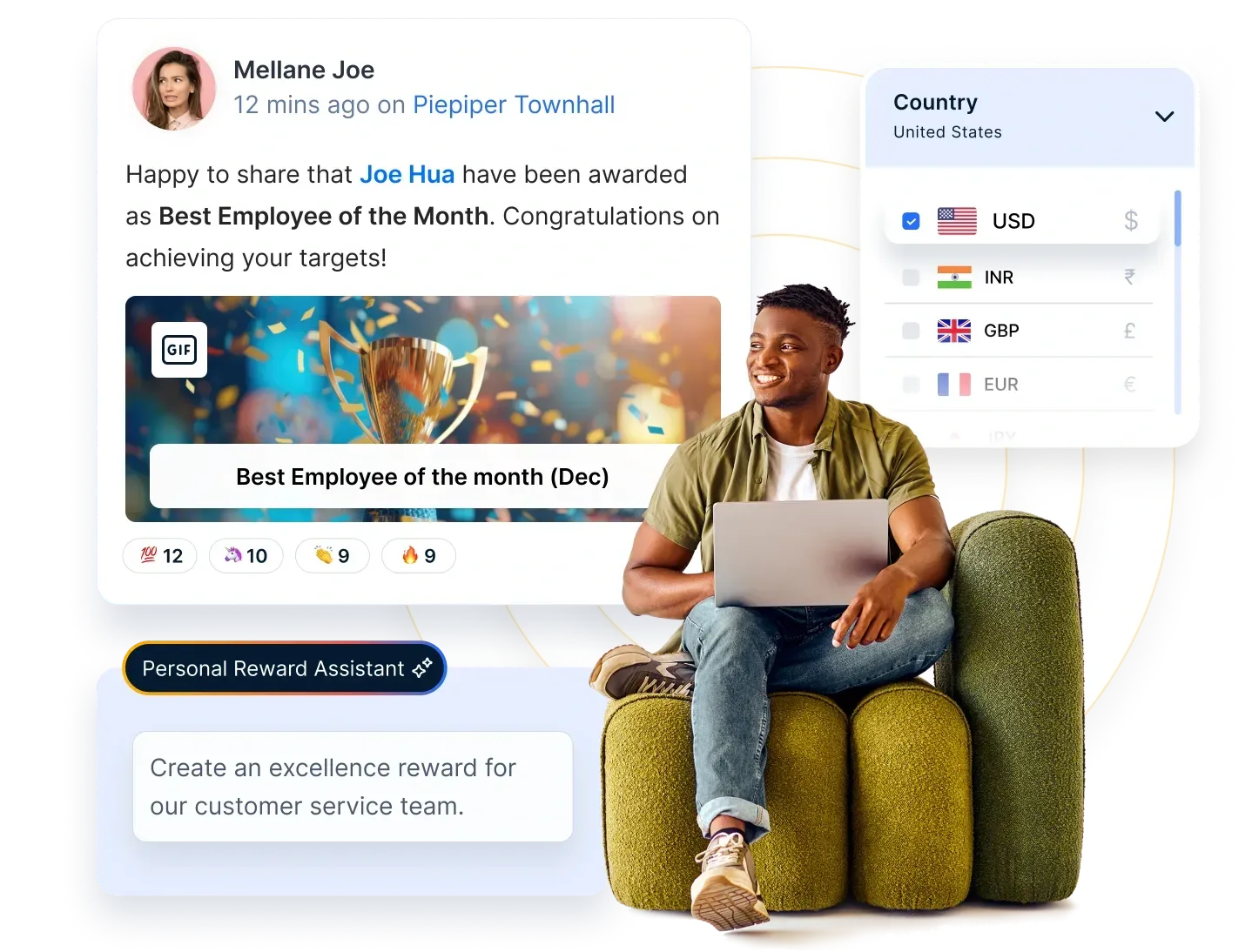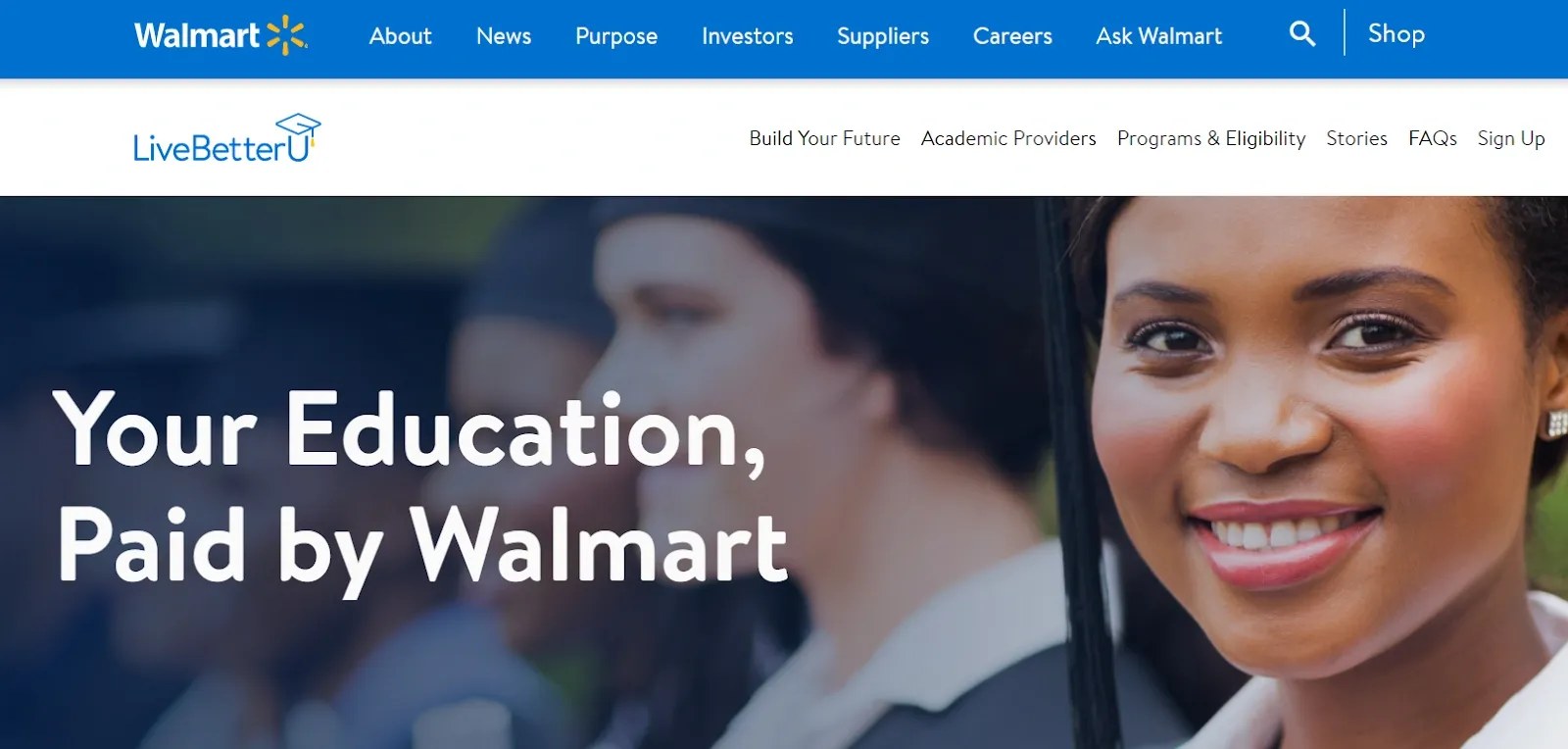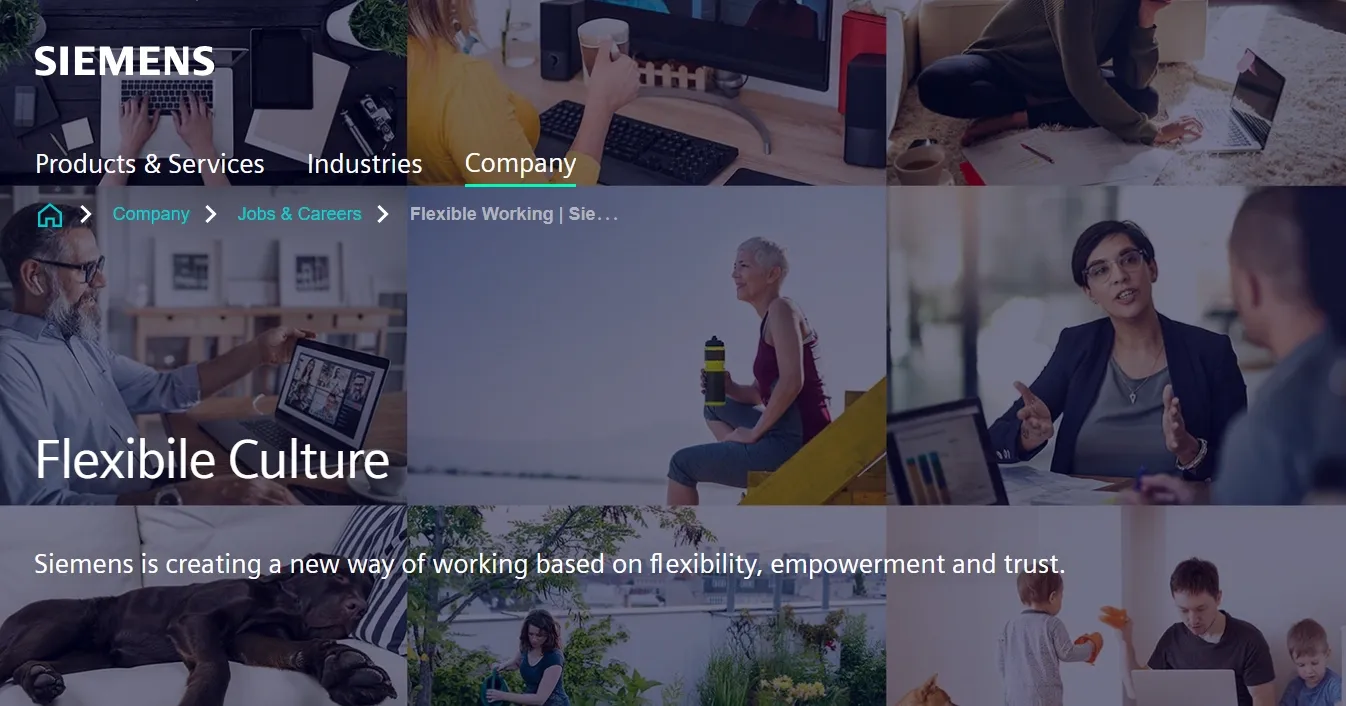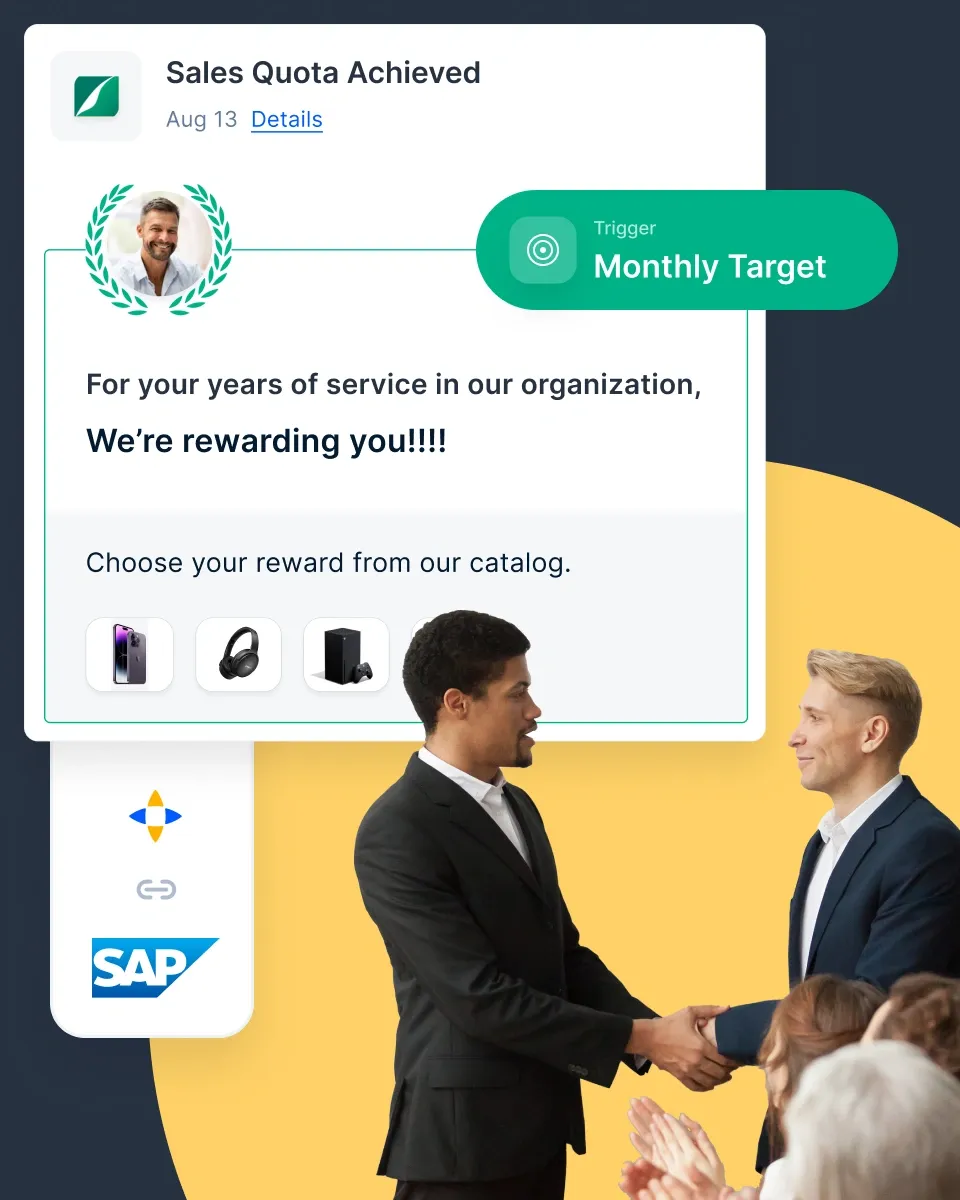Employee Retention Program & Incentive Ideas to Keep Your Best People
Découvrez de puissantes incitations pour un programme de fidélisation des employés qui améliorent l'engagement, stimulent le moral et permettent à vos meilleurs employés de rester engagés à long terme.
Sur cette page
- Qu'est-ce qu'un programme de fidélisation des employés ?
- Le rôle des incitations dans les programmes de fidélisation des salariés
- 15 idées de mesures incitatives pour mettre en place des programmes efficaces de fidélisation des salariés
- Entreprises ayant les meilleurs programmes de fidélisation des salariés
- Construire une culture de la rétention avec Empuls
- Conclusion
- FAQs
Attirer les meilleurs talents n'est que la moitié de la bataille - les garder engagés et motivés est le véritable défi. La concurrence pour les employés qualifiés s'intensifiant, les entreprises doivent investir dans des programmes de fidélisation des employés qui favorisent la loyauté et la satisfaction au travail.
Une stratégie de fidélisation bien structurée va au-delà du salaire - elle implique la création d'un environnement de travail où les employés se sentent valorisés, soutenus et motivés pour évoluer. Les incitations à la fidélisation des salariés, telles que les primes de performance, les avantages liés au bien-être et les opportunités de développement de carrière, jouent un rôle crucial dans la réduction du taux de rotation et le renforcement de la stabilité de la main-d'œuvre.
Mais quelles sont les mesures incitatives les plus efficaces pour retenir les employés ? Des programmes de reconnaissance aux modalités de travail flexibles, cet article explore les stratégies éprouvées qui aident les entreprises à conserver leurs meilleurs talents et à créer un environnement de travail prospère.
Plongeons dans le vif du sujet.
Qu'est-ce qu'un programme de fidélisation des employés ?
Un programme de fidélisation des employés est une stratégie structurée conçue pour maintenir les employés engagés, satisfaits et dévoués à une organisation à long terme. Ces programmes visent à réduire le taux de rotation en améliorant la culture du lieu de travail, en offrant des possibilités d'évolution et en veillant à ce que les employés se sentent valorisés et soutenus.
Les éléments clés d'un programme efficace de fidélisation des employés :
- Reconnaissance et récompenses: Reconnaître les contributions des employés par des incitations, des primes et des plateformes telles qu'Empuls renforce la motivation et la satisfaction au travail.
- Une rémunération et des avantages compétitifs: En offrant des salaires, des prestations de santé et des avantages sociaux exonérés d'impôts équitables, les employés sont moins enclins à chercher des opportunités ailleurs.
- Croissance et développement de la carrière: La formation, le mentorat et des plans de carrière clairs aident les employés à envisager un avenir au sein de l'organisation.
- Initiatives en faveur de l'équilibre entre vie professionnelle et vie privée: Les modalités de travail flexibles, les options de travail à distance et les programmes de bien-être réduisent l'épuisement professionnel et améliorent la rétention globale.
- Une culture d'entreprise et une communication fortes: Encourager la transparence, la collaboration et le retour d'information des employés favorise le sentiment d'appartenance et l'engagement.
Un programme de fidélisation des employés bien exécuté ne se contente pas de réduire le taux de rotation, mais améliore également la productivité, le moral et les performances globales de l'entreprise. Les organisations qui investissent dans des stratégies de fidélisation créent un lieu de travail où les employés souhaitent rester et évoluer.
Le rôle des incitations dans les programmes de fidélisation des salariés
Maintenir l'engagement et la motivation des employés est un défi permanent pour les entreprises. Si la culture d'entreprise et les possibilités d'évolution de carrière sont importantes, les mesures d'incitation jouent un rôle crucial pour garantir que les employés restent engagés sur le long terme.
Qu'il s'agisse de primes monétaires, de programmes de reconnaissance ou d'avantages liés à l'évolution de la carrière, des mesures incitatives bien conçues créent un environnement de travail où les employés se sentent valorisés et motivés.
La fidélisation des employés ne consiste pas seulement à réduire le taux de rotation, mais aussi à renforcer la loyauté et à favoriser un environnement de travail positif. Les mesures incitatives sont utiles à cet égard :
- Stimuler le moral : Les employés qui se sentent appréciés sont plus susceptibles de rester motivés et productifs.
- Encourager les performances : Les incitations basées sur les performances poussent les employés à atteindre et à dépasser leurs objectifs.
- Améliorer la satisfaction au travail : Les avantages tels que les programmes de bien-être ou les congés payés supplémentaires contribuent à un meilleur équilibre entre vie professionnelle et vie privée.
- Favoriser la loyauté : Une structure d'incitation solide permet aux employés de se sentir valorisés, ce qui réduit la probabilité qu'ils cherchent des opportunités ailleurs.
- Renforcer la culture d'entreprise : Lorsque les employés sont récompensés pour leur contribution, ils sont plus enclins à adhérer à la vision et aux valeurs de l'entreprise.

Créer un lieu de travail que les employés ne veulent pas quitter
Garder les meilleurs talents n'est pas seulement une question de salaire, c'est aussi une question de création d'un lieu de travail qu'ils aiment. Empuls vous aide à favoriser l'engagement, à récompenser les contributions et à renforcer les liens au sein de l'équipe.
15 idées de mesures incitatives pour mettre en place des programmes efficaces de fidélisation des salariés
Naturellement, vous devez parfois faire un effort actif pour retenir vos employés. La mise en œuvre de mesures incitatives dans le cadre d'un programme de fidélisation du personnel peut constituer une approche efficace. Voici donc 15 idées à prendre en considération.
1. Promotions internes
Vos employés ont besoin de savoir que, le moment venu, vous ne ferez pas venir quelqu'un d'autre pour le placer à un poste de direction. Ils veulent que ce soit quelqu'un issu des rangs. Même si ce n'est pas eux, en promouvant l'un de leurs collègues, vous leur donnez également l'espoir que cela pourrait se produire pour eux à un moment donné.
2. Primes de performance
Ce point est assez simple et ne nécessite pas beaucoup d'explications : si vos employés font un excellent travail, vous voulez les récompenser financièrement. La différence entre une prime de performance et un salaire, c'est qu'ils s'attendent et ont l'impression de mériter le second, et ne ressentent donc pas de gratitude à son égard. Les primes sont perçues différemment.
3. Réduction pour les employés
Vous pouvez offrir à vos employés une réduction spéciale s'ils sont également vos clients. Ils peuvent ainsi gagner du crédit social en commandant un article pour un ami ou un membre de leur famille en utilisant leur réduction.
4. Jours de vacances supplémentaires
Comme pour les primes, ils ont déjà droit à leurs jours de vacances, mais pourquoi ne pas leur accorder quelques jours supplémentaires pour les récompenser de leur comportement exemplaire et de leurs performances admirables ? Ce n'est pas grand-chose pour vous, mais cela peut faire la différence pour eux.
5. Anniversaires de travail
Au bout d'un certain temps, vos collaborateurs peuvent avoir l'impression que vous les tenez pour acquis. Pourquoi ne pas organiser une fête d'anniversaire et même leur offrir un cadeau pour leur montrer que ce n'est pas le cas ?
6. Participation aux bénéfices
Pourquoi votre personnel se soucierait-il de l'issue d'un projet s'il perçoit un salaire ? Que le projet réussisse ou échoue, leur revenu n'est pas affecté. Bien sûr, la réputation de l'entreprise et la santé à long terme les affectent également, mais cela est trop abstrait et trop éloigné dans le temps. Commencez plutôt à baser leurs primes sur le pourcentage de profit.
7. Leur donner des actions de votre entreprise
En récompensant vos employés fidèles par des actions de votre entreprise, vous leur donnez une raison de faire plus d'efforts. L'une des façons les plus incitatives d'aborder cette question est de donner à vos employés le sentiment d'être propriétaires de l'entreprise. Ainsi, il ne s'agit pas seulement d'un sentiment, mais d'une action.
8. Programmes de développement de carrière
Les gens quittent souvent votre entreprise parce qu'ils ne pensent pas avoir un avenir dans votre entreprise. Toutefois, s'ils disposaient d'une feuille de route pour l'évolution de leur carrière, ils ne seraient pas aussi pressés de partir.
9. Événements sociaux parrainés par l'entreprise
Les activités de consolidation d'équipe ont leur utilité, mais pour la plupart des membres de votre personnel, elles ne sont qu'une excuse pour que l'équipe s'amuse. Envisagez donc d'emmener votre équipe au paintball ou dans une salle d'évasion pour créer des liens.
10. Programme de référencement des employés
Chaque fois qu'un poste est à pourvoir, demandez à vos employés de recommander quelqu'un. Cela leur montrera que vous appréciez leur opinion et, comme pour la remise, c'est une excellente occasion pour eux de gagner des points sociaux.
11. Projets spéciaux
Certaines personnes abandonnent leur employeur parce qu'elles ne se sentent pas stimulées. Par conséquent, lorsque vous avez l'impression que quelqu'un n'a pas été "mis au défi" depuis trop longtemps, confiez-lui un projet ou une mission spéciale.
12. Modalités de travail flexibles
Ce n'est pas la même chose que d'accorder des heures de travail spéciales à tout le monde. Pourquoi quelqu'un se sentirait-il spécial ou reconnaissant s'il s'agit de votre modèle d'entreprise standard ? En revanche, vous pouvez accorder des "privilèges" en matière d'horaires de travail flexibles à certaines personnes.
13. Programmes de bien-être des employés
Se surpasser pour offrir des privilèges spéciaux à vos employés est un excellent moyen de leur montrer que vous vous souciez d'eux. Un abonnement à une salle de sport, à un club de yoga ou à une bibliothèque n'est pas très onéreux, mais il a un effet psychologique important sur votre personnel.
14. Amélioration de l'assurance maladie
La qualité de votre programme d'assurance maladie peut montrer que vous vous souciez vraiment de vos employés et qu'il vaut la peine de les garder à votre service. Une police standard est plus que ce que certains lieux de travail offrent, mais le fait d'aller au-delà aura toujours un impact plus profond.
15. Possibilités de mentorat
Les gens aiment travailler avec des experts, ce qui est extrêmement bénéfique pour leurs plans de carrière. Par conséquent, si vous employez des personnes réputées et des experts du secteur, le reste de votre personnel pourrait être incité à rester plus longtemps dans votre entreprise.
Entreprises ayant les meilleurs programmes de fidélisation des salariés
Les grandes entreprises du monde entier accordent la priorité au bonheur et à l'engagement de leurs employés. Elles ont mis en œuvre des stratégies spécifiques pour améliorer la fidélisation, et voici cinq exemples concrets pour vous inspirer :
1. Soutenir la formation continue, comme Walmart

Les employés peuvent partir pour poursuivre leurs études, ce qui peut être une perte pour l'entreprise. En soutenant leurs objectifs éducatifs, vous pouvez les garder à bord.
L'approche de Walmart : Elle s'associe à des universités pour proposer des cours à prix réduit. La formation continue est essentielle pour la fidélisation des employés de Walmart. 70% des employés qui ont suivi une formation restent plus longtemps que ceux qui n'en ont pas suivi.
Impact : L'entreprise a constaté une réduction de 30 % des taux de rotation dans les secteurs bénéficiant de programmes d'amélioration des compétences, ce qui met en évidence le lien entre le développement des employés et l'amélioration de la fidélisation.
2. Utiliser des aperçus d'emplois réalistes, comme ceux des hôtels Hilton

Lorsque les employés ont des attentes irréalistes à l'égard de leur travail, ils sont susceptibles de partir prématurément. Un aperçu réaliste du poste permet de fixer des attentes précises dès le départ.
L'approche de Hilton : Le programme "Passport to Success" de Hilton a permis d'améliorer la fidélisation des employés, avec un taux de fidélisation de 96% et un taux de promotion de 40 % parmi le personnel formé en l'espace de six mois.
Impact : Le succès du programme, qui a permis de former plus de 15 000 employés et de doubler sa portée grâce à des modules en ligne, montre comment le renforcement ciblé des compétences favorise la fidélisation et l'évolution des carrières.
3. Favoriser un environnement de travail flexible, à l'instar de Siemens

Un environnement de travail favorable est essentiel pour la fidélisation du personnel. Les employés ont des besoins différents, comme les nouveaux parents qui ont besoin de congés ou les personnes qui souhaitent travailler à distance.
L'approche de Siemens : L'entreprise a mis en place une politique de flexibilité dirigée par les employés (ELF), qui autorise le travail à temps partiel et les options à distance sans passer par un long processus d'approbation. Cela permet aux employés de concilier leur travail et leur vie personnelle.
L'impact : Une enquête de FlexJobs a révélé que 80% des employés seraient plus fidèles à leur employeur s'ils bénéficiaient d'options de travail flexibles.
4. Communiquer dans les moments difficiles, comme Gucci
Les récessions économiques peuvent inquiéter les employés et les inciter à quitter l'entreprise. Une communication claire et un soutien peuvent éviter cela.
L'approche de Gucci : Lors d'un ralentissement des ventes, le PDG a rassuré les employés par le biais d'un message vidéo, les encourageant à rester positifs et concentrés. Cette transparence a permis de maintenir la confiance et le moral.
Impact : Le fait que Marco Bizzarri, PDG de Gucci, ait rassuré les employés lors d'un ralentissement de la croissance des ventes a probablement contribué à maintenir le moral et la loyauté des employés. Des études montrent que les entreprises dont les employés sont engagés voient leur rentabilité augmenter de 21 % et leur taux de rotation des effectifs diminuer de 59 %. 59 % de réduction du taux de rotation du personnel. Malgré le ralentissement de la croissance de Gucci, qui est passée de 48,7 % à 40,1 %, la communication de Bizzarri a probablement renforcé la confiance et la fidélisation des employés.
Ces stratégies simples montrent que la satisfaction et l'engagement des salariés ne se limitent pas au salaire et aux avantages sociaux. En proposant des parcours de carrière clairs, en soutenant la formation, en fixant des attentes réalistes en matière d'emploi, en offrant des options de travail flexibles et en maintenant une communication ouverte, vous pouvez créer un environnement de travail dans lequel les employés se sentent valorisés et motivés pour rester.
Construire une culture de la rétention avec Empuls

La fidélisation des employés n'est pas seulement une question de salaire compétitif ou d'avantages occasionnels - il s'agit de créer un environnement dans lequel les employés se sentent valorisés, motivés et connectés. Un programme solide de fidélisation des employés garantit que l'engagement et la reconnaissance font partie de la culture de travail quotidienne.
C'est là qu'Empuls fait la différence. En intégrant les récompenses, la reconnaissance et le feedback en temps réel dans une plateforme unique, Empuls aide les entreprises à créer un lieu de travail où les employés se sentent appréciés et incités à rester.
- Reconnaissance et récompenses continues - Célébrez les réalisations, les étapes importantes et les contributions quotidiennes avec des incitations personnalisées qui comptent vraiment.
- Feedback des employés en temps réel - Comprenez les niveaux d'engagement et recueillez des informations à l'aide d'enquêtes et d'analyses de sentiments afin de traiter les problèmes avant qu'ils ne s'aggravent.
- Reconnaissance transparente de pair à pair - Encouragez une culture d'appréciation en permettant aux employés de se reconnaître et de se récompenser mutuellement sans effort.
- Incitations et avantages personnalisés - Offrez des récompenses flexibles qui s'alignent sur les préférences des employés, en veillant à ce que chaque moment de reconnaissance soit significatif.
- Des liens plus forts sur le lieu de travail - Favoriser la cohésion de l'équipe et la collaboration grâce à des fonctions d'engagement social, en aidant les employés à se sentir plus proches de l'organisation.
La fidélisation ne consiste pas seulement à réduire le taux de rotation, mais aussi à maintenir l'engagement des employés et à les motiver pour qu'ils donnent le meilleur d'eux-mêmes. Empuls aide les organisations à créer une culture où les employés choisissent de rester, de grandir et de s'épanouir.
Conclusion
La fidélisation des employés est essentielle pour les organisations qui cherchent à maintenir la productivité, le moral et la continuité. Des programmes de fidélisation efficaces réduisent les coûts liés au renouvellement du personnel et favorisent une main-d'œuvre loyale et motivée.
Les organisations peuvent améliorer de manière significative la satisfaction et la loyauté des employés grâce à une intégration complète, une formation et un développement continus, une reconnaissance et des récompenses, des conditions de travail flexibles, des programmes de bien-être pour les employés et une culture d'entreprise forte.
Des exemples de grandes entreprises américaines telles que Google, AT&T, Adobe, Microsoft et Johnson & Johnson démontrent le succès de ces stratégies.
En investissant dans le développement professionnel et le bien-être de leurs employés, les entreprises peuvent créer un environnement de travail favorable et motivant, ce qui se traduit par des taux de rétention plus élevés et une réussite globale de l'organisation.
FAQs
1. Quel est l'impact de l'apprentissage et du développement continus sur la fidélisation ?
En offrant des possibilités d'apprentissage et de développement continus, les employés se sentent valorisés et investis, ce qui augmente la probabilité qu'ils restent dans l'entreprise. Par exemple, l'initiative Future Ready d'AT&T propose des formations approfondies, ce qui se traduit par une main-d'œuvre plus qualifiée et plus loyale.
2. Quel rôle les programmes de reconnaissance et de récompense jouent-ils dans la fidélisation ?
Les programmes de reconnaissance et de récompense stimulent le moral et la loyauté des employés. Par exemple, le programme "Check-in" d'Adobe, qui remplace les évaluations annuelles par un retour d'information continu, a permis d'accroître l'engagement du personnel et de réduire le taux de rotation de 31 %.
3. Comment les formules de travail flexibles influencent-elles la fidélisation des employés ?
Les modalités de travail flexibles, telles que le travail à distance et les horaires flexibles, ont un impact significatif sur la satisfaction et la fidélisation des employés. Les nombreuses options de travail flexible de Microsoft ont montré que 80 % des employés seraient plus fidèles s'ils disposaient de telles options.
4. Comment une culture d'entreprise forte influe-t-elle sur la fidélisation des employés ?
Une culture d'entreprise forte qui s'aligne sur les valeurs des employés favorise un sentiment d'appartenance et de loyauté. L'accent mis par Patagonia sur la durabilité environnementale et la responsabilité de l'entreprise a créé un environnement de travail positif, ce qui a considérablement amélioré la rétention du personnel.
5. Quelles sont les idées les plus simples pour favoriser la fidélisation des employés ?
Des stratégies simples consistent à soutenir la formation continue (par exemple, le partenariat de Walmart avec les universités), à fournir des aperçus réalistes de l'emploi (par exemple, le programme "Passport to Success" de Hilton), à favoriser un environnement de travail flexible (par exemple, la politique ELF de Siemens) et à communiquer pendant les périodes difficiles (par exemple, les propos rassurants du PDG de Gucci pendant le ralentissement des ventes).













